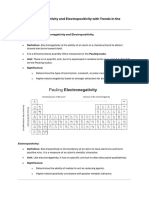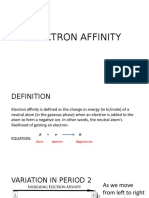Orangic Chemistry 1 Study Guide
Orangic Chemistry 1 Study Guide
Uploaded by
anmol3Copyright:
Available Formats
Orangic Chemistry 1 Study Guide
Orangic Chemistry 1 Study Guide
Uploaded by
anmol3Original Description:
Copyright
Available Formats
Share this document
Did you find this document useful?
Is this content inappropriate?
Copyright:
Available Formats
Orangic Chemistry 1 Study Guide
Orangic Chemistry 1 Study Guide
Uploaded by
anmol3Copyright:
Available Formats
Organic Chemistry 1 Study Guide
Electrophile
Electron Loving
Electron Deficient
Accepts Electrons
Identify Electrophile:
1. Positive charge system can act as an electrophile (NO+, X+, Ph-N2+, etc.)
2. Neutral Molecules are electrophiles
Nucleophile
Nucleus Loving
Electron Rich
Donate Electron
Identify Nucleophile
1. All Negative charges act as nucleophile (H-, OH-, NH2-, X-, etc.)
2. Neutral Molecule WITH central atom having at least one lone pair of electrons
(H2O, NH3)
3. A electron system can act as nucleophile (Ex: Alkene, Alkyne, etc.)
4. Metals
Electronic Effects
Influences Structures, reactivity, or properties of molecules but is neither a traditional
bond nor a steric effect.
Release of e- or attraction of e- :
Resonance Effects
1. Shift of lone pairs of e- and/or bonds of e Inductive Effects
1. Shift of e- in sigma () bonds
Inductive Effects are always weaker than resonance effects b/c e- are more localized in
bonds.
Resonance Effects
Ability to delocalize (SPREAD OUT) charge
Goal is to redistribute the electrons in bonds
Delocalize charge over more than one atom INCREASES stability of charged
species.
Generally, more resonance structures = more stable
Taking electrons from an area that has an excess e- to an area with little electrons
(+ charge)
Most stable resonance forms:
1. Every single atom has an octet
2. Minimize number of charges
CHCl3 is more acidic than CHF3
Mainly for multiple bonds
Resonance Examples
RESONANCE STABILITY RULES OF NEGATIVE CHARGES
RESONANCE STABILITY RULES OF POSITIVE CHARGES
Electronic Effects (continued)
Inductive Effects
o Electronic effects due to polarization of bonds within a molecule or ion
o Electronegativity difference b/w the atoms at either end of bonds
o The effect on electron density in one portion of molecules due to electronwithdrawing or electron-donating groups elsewhere in molecules
o Induction effect of an atom depends on 3 things
1. Electronegativity
The effect on electron density in one portion of a molecule due to
electron-withdrawing or electron-donating groups elsewhere in the
molecule
In a covalent bond between two atoms of unequal
electronegativity, the atom with higher electronegativity withdraws
(pulls) electron density towards itself, causing + and - charges of
the bond dipole
Addition of a electronegative atom causes the molecule to be more
acidic.
2. Bonding Order and Charge
3. Position Within a Structure
o Negative Inductive Effects (-I)
The most electronegative atom will pull the electron away from the other
atoms. However, as you move further AWAY from the most
electronegative atom the electropositivity increases
Electron Withdrawing Effect
o Positive Inductive Effect (+I)
When electropositive atom or group is attached to the terminal of the
carbon chain in a compound, the electrons are DISPLACED away from
the attached atom or group
Electrons want to get as far away as possible from the electropositive
group
Electron releasing effect
You might also like
- Experiment 5 - Reaction RateDocument3 pagesExperiment 5 - Reaction RateNicola Olivia Mitschek100% (1)
- (Lab Report Operation Unit) Experiment 1 (A) Measuring Specific Gravity of A Liquid by Using Measuring Beaker, Eureka Can, Density Bottle and Hydrometer MethodDocument6 pages(Lab Report Operation Unit) Experiment 1 (A) Measuring Specific Gravity of A Liquid by Using Measuring Beaker, Eureka Can, Density Bottle and Hydrometer MethodFazsroul100% (1)
- Unit-I - Reaction MechanismsDocument52 pagesUnit-I - Reaction Mechanismschetanptl113No ratings yet
- 1456897461CHE P1 M1 E-Text PDFDocument14 pages1456897461CHE P1 M1 E-Text PDFanu MalikNo ratings yet
- Opposites Attract and Like Repel.: Inductive Effect Resonance EffectDocument12 pagesOpposites Attract and Like Repel.: Inductive Effect Resonance EffectAwais Arshad0% (1)
- Lecture-Electronegativity and Electropositivity With Trends in The Periodic TableDocument13 pagesLecture-Electronegativity and Electropositivity With Trends in The Periodic TableABEERA SHAEERNo ratings yet
- Electrone Displacement Type in Organic ReactionsDocument4 pagesElectrone Displacement Type in Organic ReactionsSuraj YadavNo ratings yet
- Electron Availability - CHM 235-ContinuationDocument8 pagesElectron Availability - CHM 235-Continuationfarouqrazaq54No ratings yet
- Electron Displacement EffectDocument12 pagesElectron Displacement EffectManoj KhanalNo ratings yet
- Hemical Onding: Saman Kotigala BSC MSCDocument24 pagesHemical Onding: Saman Kotigala BSC MSCSaman Bharatha Kotigala100% (1)
- Electron Displacement EffectDocument12 pagesElectron Displacement EffectOmkar Kumar JhaNo ratings yet
- ChemistryDocument36 pagesChemistryAyansh ChourasiyaNo ratings yet
- And CL Ions: Basic Concepts of Chemical BondingDocument3 pagesAnd CL Ions: Basic Concepts of Chemical BondingMike AndersonNo ratings yet
- Engineering Chemistry Notes UNIT 4Document9 pagesEngineering Chemistry Notes UNIT 4Nivetha ENo ratings yet
- 7 GlossaryDocument8 pages7 GlossaryEhtıram SeyıdovNo ratings yet
- Inductive Effect: The Inductive Effect Is A Distance-Dependent PhenomenonDocument6 pagesInductive Effect: The Inductive Effect Is A Distance-Dependent Phenomenonnil kumarNo ratings yet
- An Introduction To Organic ChemistryDocument16 pagesAn Introduction To Organic ChemistryJotillnaimNo ratings yet
- Organic Chemistry Structural EffectsDocument3 pagesOrganic Chemistry Structural EffectsOrlando Angelo Cerezo100% (2)
- CHE-502 Lecture 3 Oraginic Chemistry (Reaction Intermediates) by Dr. Charu C. PantDocument41 pagesCHE-502 Lecture 3 Oraginic Chemistry (Reaction Intermediates) by Dr. Charu C. Panthass84210100% (1)
- Introduction To Chemical Bonding-2024Document22 pagesIntroduction To Chemical Bonding-2024Mohamed WeyimiNo ratings yet
- Periodicity of PropertiesDocument5 pagesPeriodicity of PropertiesHaYem AlnNo ratings yet
- 8.4: Bond Polarity and ElectronegativityDocument8 pages8.4: Bond Polarity and ElectronegativityHarshal BandkarNo ratings yet
- An Overview in Organic ReactionDocument19 pagesAn Overview in Organic ReactionKhoiriyah Nur AiniNo ratings yet
- Fundamental Principles of Organic ChemistryDocument16 pagesFundamental Principles of Organic ChemistryNewton SirNo ratings yet
- 8 Comparison of Resonance and Inductive EffectsDocument1 page8 Comparison of Resonance and Inductive EffectsA GEETHANo ratings yet
- # Week 3 NotesDocument13 pages# Week 3 Notestimx123yNo ratings yet
- Electron Migration Effects NotesDocument3 pagesElectron Migration Effects Noteskrishneet641No ratings yet
- Chemistry: The Central Science: 8.S: Basic Concepts of Chemical Bonding (Summary)Document6 pagesChemistry: The Central Science: 8.S: Basic Concepts of Chemical Bonding (Summary)Harshal BandkarNo ratings yet
- EnE 250 Air Quality Management and Pollution Control Lecture 03 - 2 Characterizing Air Pollution Oct 2015Document115 pagesEnE 250 Air Quality Management and Pollution Control Lecture 03 - 2 Characterizing Air Pollution Oct 2015Alexis Bryan RiveraNo ratings yet
- Bonding Ionic CovalentDocument30 pagesBonding Ionic CovalentRaul MejiaNo ratings yet
- Electron AffinityDocument51 pagesElectron AffinityS K MishraNo ratings yet
- Inductive EffectDocument7 pagesInductive Effectnil kumarNo ratings yet
- General Organic Chemistry For IITDocument21 pagesGeneral Organic Chemistry For IITParas Thakur83% (6)
- Periodic Table (4,5,6)Document37 pagesPeriodic Table (4,5,6)rehanfazal9669No ratings yet
- Arrow PushingDocument5 pagesArrow PushingJesús PortilloNo ratings yet
- Electron Affinity Is The Measure of TheDocument1 pageElectron Affinity Is The Measure of TherandypagatpatNo ratings yet
- Periodic Properties Copy 2Document30 pagesPeriodic Properties Copy 2Rodayna HosniNo ratings yet
- Chemical Bonding and Molecular StructureDocument13 pagesChemical Bonding and Molecular StructureVishal Malik100% (1)
- Electronegativity and Its ApplicationsDocument6 pagesElectronegativity and Its ApplicationsShamzaSeemin100% (1)
- Basic Concepts of Chemical BondingDocument46 pagesBasic Concepts of Chemical BondingHendri KurniawanNo ratings yet
- Trends in The Periodic TableDocument25 pagesTrends in The Periodic TableHanna GalatiNo ratings yet
- Chapter - 13 Concepts in Organic ChemistryDocument4 pagesChapter - 13 Concepts in Organic Chemistryanon_352928797No ratings yet
- Inductive EffectDocument70 pagesInductive EffectDeepak100% (2)
- ELECTRONEGATIVITYDocument7 pagesELECTRONEGATIVITYRohini SelvarajahNo ratings yet
- CHAPTER 2 Lewis Dot DiagramsDocument8 pagesCHAPTER 2 Lewis Dot DiagramsPreety SekhonNo ratings yet
- Periodic Properties - Unit 1 FullDocument85 pagesPeriodic Properties - Unit 1 FullrajeevatyNo ratings yet
- Say Chemical Bonding and Molecular StructureDocument13 pagesSay Chemical Bonding and Molecular Structuresivaranjini S.VNo ratings yet
- Diploe Moment and Inductive Effect Final VersionDocument45 pagesDiploe Moment and Inductive Effect Final VersionIqra BaigNo ratings yet
- Pptx5 Chemical BondingDocument39 pagesPptx5 Chemical BondingLumbay, Jolly MaeNo ratings yet
- Chemical Bonding and Molecular StructureDocument14 pagesChemical Bonding and Molecular StructureRoshita G PillaiNo ratings yet
- Chemical Bonding and Molecular StructureDocument14 pagesChemical Bonding and Molecular StructureRoshita G PillaiNo ratings yet
- Chemical Bonding Ionic Bonding Characteristics of Ionic CompoundsDocument2 pagesChemical Bonding Ionic Bonding Characteristics of Ionic CompoundsBittu100% (1)
- ChemistryDocument8 pagesChemistryJHALAK SINGHNo ratings yet
- Chemical Bonding ScriptDocument4 pagesChemical Bonding ScriptAkhil MathewNo ratings yet
- Topic 1 - Introduction Learning Objectives:: Module 1 - Organic ChemistryDocument8 pagesTopic 1 - Introduction Learning Objectives:: Module 1 - Organic ChemistryTwinkle ToesNo ratings yet
- What is Charge? – The Redefinition of Atom - Energy to Matter ConversionFrom EverandWhat is Charge? – The Redefinition of Atom - Energy to Matter ConversionNo ratings yet
- A-Level Chemistry Revision: Cheeky Revision ShortcutsFrom EverandA-Level Chemistry Revision: Cheeky Revision ShortcutsRating: 4 out of 5 stars4/5 (5)
- PF ST EcoMi KTS ENDocument2 pagesPF ST EcoMi KTS ENlatjaviNo ratings yet
- Hach Online Alkalinity MonitorDocument5 pagesHach Online Alkalinity MonitorArul KumarNo ratings yet
- Prepared by Dr.A.Vinoth JebarajDocument66 pagesPrepared by Dr.A.Vinoth JebarajMEGHA JAINNo ratings yet
- Open Graded Friction Courses 1 - 757265452 - 162006144224Document4 pagesOpen Graded Friction Courses 1 - 757265452 - 162006144224jaafar abdullahNo ratings yet
- Semiconductor SpintronicsDocument343 pagesSemiconductor Spintronicsmayankbehl100% (1)
- PHOTOCONDUCTIVITYDocument39 pagesPHOTOCONDUCTIVITYSuhaila ctNo ratings yet
- PdfjoinerDocument6 pagesPdfjoinerClaudia MadalinaNo ratings yet
- Moisture Uptake Dynamics On Desiccant-Coated, Water-Sorbing Heat ExchangerDocument10 pagesMoisture Uptake Dynamics On Desiccant-Coated, Water-Sorbing Heat ExchangerBibhas NayakNo ratings yet
- Dielectrics Lecture Notes PDFDocument33 pagesDielectrics Lecture Notes PDFGokul Subramanyan100% (1)
- Aluminium Aluminum 6013 Alloy (UNS A96013)Document3 pagesAluminium Aluminum 6013 Alloy (UNS A96013)HARIPRASATH PNo ratings yet
- PHYSICS-Extra Questions 1 REVIEW TEST-6Document30 pagesPHYSICS-Extra Questions 1 REVIEW TEST-6Raju SinghNo ratings yet
- Neodol 91: Linear Primary AlcoholDocument2 pagesNeodol 91: Linear Primary AlcoholRAFAEL MIERESNo ratings yet
- ThermoDocument17 pagesThermoAira Krizelle100% (1)
- Astrology and Marriage - SepharialDocument32 pagesAstrology and Marriage - Sepharialewfsd100% (2)
- GCE-Chemistry-467-Summer2022-AS 1, Basic Concepts in Physical and Inorganic Chemistry-PaperDocument22 pagesGCE-Chemistry-467-Summer2022-AS 1, Basic Concepts in Physical and Inorganic Chemistry-PaperDavid McFaulNo ratings yet
- Technical Guideline No. 8 Hazardous Waste Disposal RevisedDocument16 pagesTechnical Guideline No. 8 Hazardous Waste Disposal RevisedSuhairNo ratings yet
- Spectral and Transmittance Properties of Er3+ Doped Zinc Lithium Lead Calcium Borophosphate GlassesDocument10 pagesSpectral and Transmittance Properties of Er3+ Doped Zinc Lithium Lead Calcium Borophosphate GlassesIJRASETPublicationsNo ratings yet
- PvtiDocument16 pagesPvtiDhiaa LaMiNo ratings yet
- Recurrent Difficulties: Stoichiometry Problem-SolvingDocument7 pagesRecurrent Difficulties: Stoichiometry Problem-SolvingTheesha SophieNo ratings yet
- 0625 s16 Ms 42Document10 pages0625 s16 Ms 42Abdullah NaveedNo ratings yet
- Jenion 公司 Alternating Cold Cathode Plasma SourcesDocument7 pagesJenion 公司 Alternating Cold Cathode Plasma SourcesdownbuliaoNo ratings yet
- iCE 3000 Series Detection LimitsDocument1 pageiCE 3000 Series Detection LimitsdudutwaeNo ratings yet
- Design and Fabrication of Multipurpose Agricultural MachineDocument7 pagesDesign and Fabrication of Multipurpose Agricultural MachineIJRASETPublicationsNo ratings yet
- Abbotsleigh 2021 Chemistry TrialDocument20 pagesAbbotsleigh 2021 Chemistry TrialBen MilnerNo ratings yet
- Heat Exchanger Rev - 02Document1 pageHeat Exchanger Rev - 02TKT ConsultantNo ratings yet
- HOMEWORK ASSIGNMENT 13: Solutions: Z Z 2 Z Z Z Z 2 Z Z Z Z Z 2 Z Z Z Z Z Z Z 2Document13 pagesHOMEWORK ASSIGNMENT 13: Solutions: Z Z 2 Z Z Z Z 2 Z Z Z Z Z 2 Z Z Z Z Z Z Z 2Randeep Iyyad N CNo ratings yet
- Structural Analysis and Optimization of An Automotive Propeller ShaftDocument11 pagesStructural Analysis and Optimization of An Automotive Propeller ShaftdressfeetNo ratings yet
- Chemistry 12 How Do You Find The Ion Concentration in A Tap Water SampleDocument5 pagesChemistry 12 How Do You Find The Ion Concentration in A Tap Water SampleToxicBlueNo ratings yet

























































































